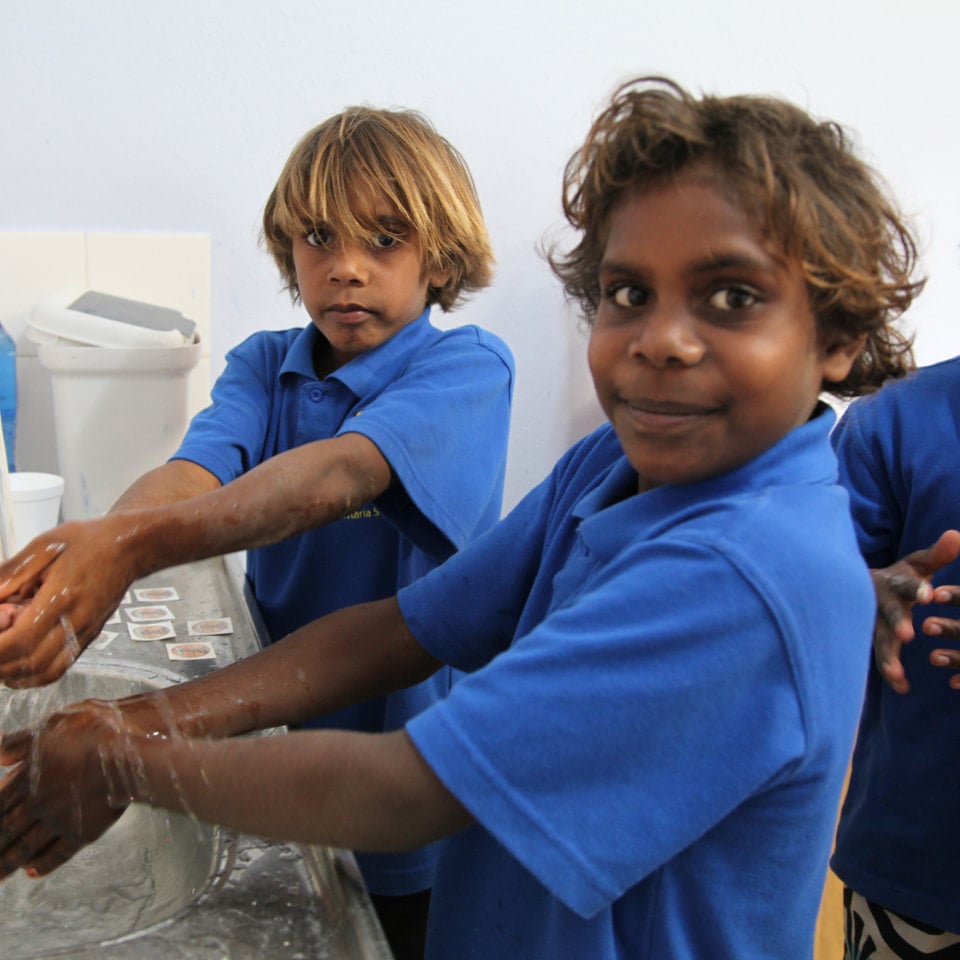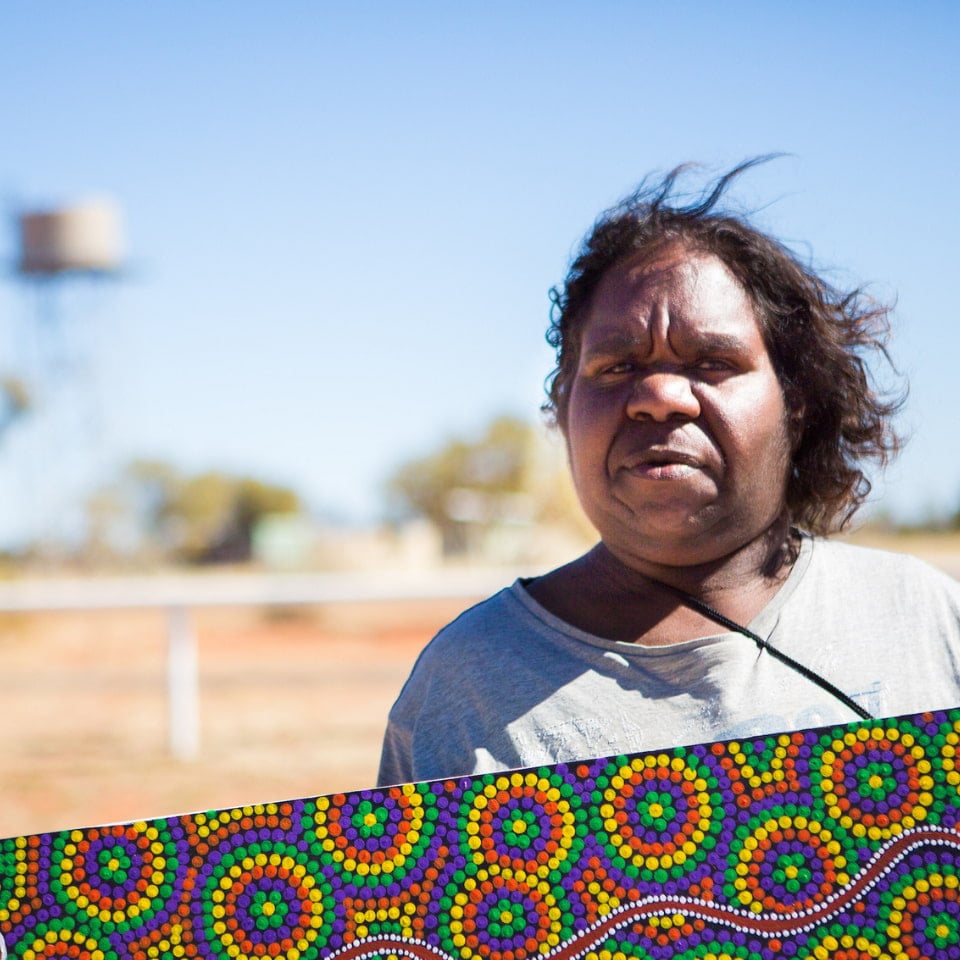Did you know that while trachoma is treatable and preventable, Australia remains the only developed country in the world where the disease still exists in endemic proportions? This lists us alongside countries such as the Democratic Republic of Congo and Afghanistan.
For The Fred Hollows Foundation, tackling trachoma has been part of our core objective from the very beginning, when Fred, Gabi and many others travelled around Australia for The National Eye Health and Trachoma Program in the 1970s.
Read on to find out more about trachoma in Aboriginal and Torres Strait Islander communities and what's being done to improve the situation.
Here's what we'll cover...
Click on the link to jump to sections that you're most interested in.
- What is trachoma?
- Trachoma in Aboriginal and Torres Strait Islander populations
- Why is trachoma common in Australia's remote Aboriginal and Torres Strait Islander communities?
- Watch: tackling trachoma in Australia during the 1970s - The National Trachoma Eye Health Program
- Treatment rates for Aboriginal and Torres Strait Islander people with trachoma
- There us an end in sight for trachoma!
- How can we beat trachoma?
- Community education program: Clean Faces, Strong Eyes
What is trachoma?
Trachoma is the leading infectious cause of blindness in the world today, occurring in communities with poor hygiene and living conditions.
The first known recorded mention of trachoma in Australia was in 1688, when the Englishman William Dampier wrote in his diary about the Aboriginal and Torres Strait Islander people he met; ‘They have great heads, round foreheads and great brows ... their eyelids are always half-closed to keep the flies out of their eyes’ (Mann, 1966) (Source: Beyond Sandy Blight, 2008).
Trachoma is most commonly contracted by young children after playing in outside in the dust and not being able to wash their faces properly.
A bacterial eye infection, trachoma is not unlike the common ‘pink-eye’ or conjunctivitis. Repeated reinfection, combined with the body’s immune reaction, often has devastating consequences.
Trachoma starts as an infection of the membrane that covers the outside of the eyeball and lines the inner surface of the eyelids (conjunctiva). Over years, repeated infections can lead to scarring that causes the margin of the eyelid to turn inwards.
What do you know about the painful disease? Check out this video to find out five facts you need to know about trachoma.
For more videos about our work and history, visit our YouTube channel.
Trachoma in Aboriginal and Torres Strait Islander populations
While Trachoma is treatable and preventable, Australia remains the only developed country in the world where the disease still exists in endemic proportions.
The sad reality is that trachoma disproportionately affects our Aboriginal and Torres Strait Islander population in Australia, particularly in rural northern and central Australia. In fact, trachoma is the fourth leading cause of blindness in Aboriginal and Torres Strait Islander people.
But here’s the thing - we haven’t seen cases of trachoma in mainstream Australia for over 100 years.
Yet, in 2016, the National Trachoma Surveillance and Reporting Unit found that of the 131 at-risk communities screened, almost 30 percent of those communities were experiencing trachoma at endemic levels.
The research found that in those communities, the trachoma prevalence rate for children aged between 5 and 9 years was 4.6 percent.
 Trachoma in Indigenous populations | Students of Hermannsburg (Ntaria) school | Photographer: Arianna Claridge | Fred Hollows Foundation (2013)
Trachoma in Indigenous populations | Students of Hermannsburg (Ntaria) school | Photographer: Arianna Claridge | Fred Hollows Foundation (2013)
Why is trachoma common?
Trachoma is common in places where there is poor water, sanitation and hygiene (WASH) conditions and practices (The University of Melbourne, Indigenous Eye Health). The dry and dusty conditions of the Australian outback, as well as insufficient housing and infrastructure can make regularly washing your hands and face very difficult!
Unfortunately, in Australia we still have remote Aboriginal communities living in these circumstances. Young children often share small rooms and pass infections onto each other. Ear and eye infections are common (like trachoma), as well as skin conditions, gastroenteritis (diarrhea and vomiting), and respiratory infections (like pneumococcal disease).
There is insufficient access to clean water, taps and sinks, as well as a lack of awareness of the importance of strict hygiene and sanitation.
It is scandalous that these nineteenth century diseases of poverty should continue.
Tackling trachoma in Australia during the 1970's
The National Trachoma and Eye Health Program
“We’d arranged to do the eye examinations at the showgrounds, a place known to everybody and where it was possible to set up equipment and keep records. I remember that it was very hot and there were dust storms and willy-willys making everything very difficult.
The first kid arrived, a five-year-old and I decided I’d examine him for trachoma, which involves everting the eyelid. I did it and there they were - those tiny accumulations of white blood cells, less than a millimetre in diameter, the trachoma follicles. I thought, Hullo, there’s one that hasn’t been picked up.
The next five children I examined all had trachoma follicles…
...In the end, we discovered that there was a great deal of trachoma among the Aborigines - none among the whites - in Bourke.”
- Fred Hollows Autobiography with Peter Corris
Treatment rates
Treatment rates among our Aboriginal and Torres Strait Islander population are also lower than their non-Indigenous counterparts. In fact, over one third of Aboriginal and Torres Strait Islanders have never even had an eye exam!
This gap in treatment rates is due to a combination of factors.
In remote communities, health care is difficult to access with limited transport options. Cultural differences between mainstream health care systems and Aboriginal and Torres Strait Islander culture can also be a major barrier to treatment.
In some communities, despite readily available health care, treatment rates remain low. This suggests that we need to improve our understanding of the needs of Aboriginal and Torres Strait Islander people who need medical treatment in Australia.
There is and end in sight for trachoma!
The World Health Organization has set targets to completely eliminate blinding trachoma by 2020. As a signatory, the Australian Government is committed to achieving this goal. In 2013, the Government funded a $58.3 million program to tackle trachoma in Australia’s Aboriginal and Torres Strait Islander communities.
The global community is on track to hit that 2020 target.
Rates of trachoma in Aboriginal and Torres Strait Islander communities are steadily falling. Between 2009 and 2016, active trachoma rates decreased by nearly 10 percent. And every day the numbers of ‘at-risk’ communities are decreasing, with only a handful still with endemic rates of trachoma.
Treatment rates are also improving. Between 2011 and 2015, treatment rates grew by 22 percent (AIHW 2016).
How can we beat trachoma?
Here at The Foundation, we work alongside Aboriginal and Torres Strait Islander communities, the Australian Government and our partner organisations to help the community realise these goals.
But we can't rest yet!
We need to maintain momentum in our programs, while continuing to place pressure on our governments for vital funding.
We also know that large-scale, adequately funded and well-coordinated public health efforts are the best way to achieve positive results.
Over the years, sustained health promotion and education programs in health services, schools and communities are making strong inroads in our goal to end trachoma.
Community education program: Clean faces, strong eyes
The “Clean Faces, Strong Eyes” program, run by the Indigenous Eye Health group at the University of Melbourne, is just one great example that has seen some exceptional results.
The program was particularly successful due to the relationship between health workers and Aboriginal and Torres Strait Islander communities, as well as the use of fun and relatable handouts and videos.
Disclaimer: The content on this page is not intended to be medical advice. For medical advice, please contact your local health professional. All statistics quoted use the most recent information available, to the best of our knowledge.
